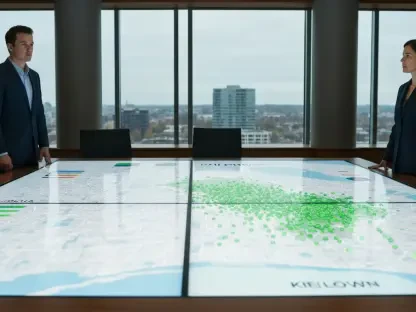Nestled in the heart of Worcestershire, England, Wyre Forest District stands as a remarkable blend of natural splendor and urban evolution, where the commitment to sustainable development shapes the future of its communities. This region, encompassing historic towns like Kidderminster, Stourport-on-Severn, and Bewdley, is home to ancient woodlands, sprawling river valleys, and vibrant urban centers that together create a unique landscape demanding thoughtful planning. Green infrastructure (GI) emerges as a cornerstone of this vision, weaving together green and blue spaces to foster healthier, more resilient environments for both people and wildlife. Inspired by the comprehensive framework laid out by local planning authorities, this exploration delves into how GI transforms new developments into sustainable havens. From the tranquility of connected trails to the practical benefits of flood mitigation, the approach in Wyre Forest offers a blueprint for balancing growth with nature. Whether addressing climate challenges or enhancing community well-being, the district paves the way for a greener tomorrow, inviting developers, residents, and nature enthusiasts alike to understand and contribute to this vital mission.
Defining the Core of Green Infrastructure
Green infrastructure, often abbreviated as GI, represents far more than mere parks or patches of greenery; it is a strategically designed network of natural and engineered spaces that underpin sustainable living across diverse landscapes. In Wyre Forest, this network spans from the expansive woodlands of the namesake forest to urban innovations like green roofs and rain gardens in bustling areas such as Kidderminster. These elements work in harmony to link wetlands, rivers, and forests into a cohesive system that supports a multitude of functions. The National Planning Policy Framework (NPPF) underscores GI as a fundamental component of sustainable development, a principle that Wyre Forest embraces with dedication. By integrating such spaces, the district aims to deliver cleaner air, enhanced wildlife habitats, and accessible areas for recreation, ensuring that environmental benefits are woven into the fabric of everyday life. This holistic approach not only elevates the aesthetic appeal of the region but also addresses critical needs like climate adaptation and community health, setting a standard for thoughtful urban planning.
At its essence, Green Infrastructure (GI) in Wyre Forest is about creating environments that adapt to modern challenges while preserving the natural heritage that defines the district. The goal is to ensure that every green space, whether a sprawling nature reserve or a small stormwater management feature, contributes to a broader network of sustainability. This involves careful planning to balance ecological integrity with human needs, such as providing areas for leisure without compromising sensitive habitats. Developers are encouraged to see GI not as an optional add-on but as an integral part of project design, aligning with national guidelines that prioritize long-term environmental health. Through this lens, the district’s commitment to GI becomes a powerful tool for building resilience, offering solutions that range from mitigating urban heat to supporting biodiversity. The result is a living, breathing infrastructure that enhances the quality of life for residents while safeguarding the planet for future generations.
The Importance of Green Infrastructure in Wyre Forest
Wyre Forest faces a distinctive set of challenges as it navigates the dual pressures of urban expansion and environmental preservation, particularly in areas like Kidderminster and along the Severn Valley. With towns growing to accommodate new residents and businesses, the risk of losing precious natural spaces such as acid grasslands and river corridors looms large. Green infrastructure offers a compelling solution by harmonizing development with nature, ensuring that growth does not erode the district’s ecological foundation. By embedding green infrastructure into planning, the region can maintain its unique character while addressing pressing issues like habitat fragmentation. This balance is crucial for sustaining the landscapes that define Wyre Forest, protecting them from the unintended consequences of unchecked urbanization while still fostering economic and social progress.
Beyond preserving the environment, GI plays a pivotal role in combating the tangible effects of climate change, a growing concern for communities across the district, and it serves as a vital strategy for enhancing resilience. Features like tree canopies and green spaces help cool urban heat islands, particularly in densely populated areas where summer temperatures can soar. Additionally, sustainable drainage systems integrated into new developments mitigate flooding risks, a persistent issue near the Severn River. These measures not only protect infrastructure but also enhance the livability of towns like Bewdley, where water management is a priority. Furthermore, GI promotes healthier lifestyles by encouraging active pursuits such as walking and cycling through well-designed trails and parks. Ultimately, the adoption of green infrastructure transforms Wyre Forest into a place where both current and future generations can thrive amidst a backdrop of natural beauty and resilience.
Policy and Planning Foundations for Sustainability
The framework guiding green infrastructure in Wyre Forest is rooted in a robust set of policies that ensure sustainability remains a priority in all development endeavors. The Wyre Forest Local Plan, spanning from its inception to 2036, establishes clear mandates through policies like SP.28, which requires green infrastructure (GI) integration in major projects across the district. Specific targets, such as allocating 40% of larger greenfield sites to green infrastructure, leave no room for ambiguity, reinforcing the expectation that developers prioritize environmental considerations. This structured approach, supported by detailed guidance in the accompanying planning documents, provides a roadmap for creating spaces that align with both local needs and broader sustainability goals. The emphasis on compliance ensures that GI is not merely aspirational but a tangible requirement shaping the district’s growth.
Complementing local policies are national directives that add significant weight to the Green Infrastructure (GI) agenda in Wyre Forest, ensuring a robust framework for sustainable development. Legislation such as the Environment Act 2021 mandates a minimum 10% biodiversity net gain for most developments, pushing for measurable ecological improvements. Additionally, county-wide initiatives like the Worcestershire Green Infrastructure Strategy align local efforts with regional objectives, fostering a cohesive network of green spaces. These combined frameworks create a comprehensive blueprint that developers must navigate, ensuring that every new neighborhood contributes to environmental health. The guidance offered through these policies also aids in translating complex requirements into actionable plans, from pre-application advice to detailed design standards. This multi-tiered policy structure underscores a collective commitment to building a sustainable future, where green infrastructure serves as a cornerstone of progress across Wyre Forest.
Designing for Multifunctionality in Green Spaces
One of the standout strengths of green infrastructure lies in its capacity for multifunctionality, a principle that maximizes the utility of limited land within Wyre Forest. A single green space in a town like Stourport-on-Severn can simultaneously serve as a flood barrier, a recreational area for families, and a sanctuary for local wildlife. This layered approach ensures that every element of green infrastructure works harder, delivering diverse benefits without requiring additional space—a critical consideration in urban environments where land is scarce. Developers are encouraged to think innovatively, designing features that blend purposes, such as walking paths that double as wildlife corridors. By adopting this mindset, projects can achieve greater efficiency, providing substantial environmental and social returns on investment in a district where every acre counts.
The emphasis on multifunctionality also reflects a pragmatic response to the complex demands of modern development in Wyre Forest, where green spaces designed with multiple roles in mind can address interconnected challenges. These challenges range from managing stormwater runoff to enhancing community cohesion through shared amenities. For instance, a park might incorporate sustainable drainage systems to prevent flooding while offering playgrounds and shaded areas for residents to unwind. Such designs not only optimize resources but also create vibrant, dynamic spaces that enrich the daily lives of those who use them. The guidance provided to developers highlights the importance of early planning to identify and integrate these overlapping functions, ensuring that green infrastructure contributes to a holistic vision of sustainability. In this way, Wyre Forest’s green spaces become powerhouses of utility, embodying the district’s commitment to innovative, impactful environmental solutions.
Building Connectivity Across Communities and Ecosystems
Connectivity stands as a central pillar in the planning of green infrastructure, aiming to create a seamless web of spaces that unite both people and nature throughout Wyre Forest. Fragmented green corridors, often disrupted by past development, can be restored through intentional design that links urban parks with rural landscapes. This approach allows wildlife to move freely, connecting habitats from the Severn River to local nature reserves via strategically placed stepping stones in new projects. Such linkages are vital for maintaining ecological balance, ensuring species can thrive despite the pressures of urban growth. The focus on connectivity transforms isolated patches of greenery into a cohesive network, amplifying their collective impact on biodiversity and environmental health across the district.
Equally important is the role of connectivity in enhancing human experiences within Wyre Forest, fostering a sense of unity and accessibility for residents while encouraging active lifestyles. Well-planned trails and cycle paths encourage active travel, reducing reliance on cars while promoting physical health and lowering carbon emissions. These pathways, spanning from bustling town centers to serene countryside, create opportunities for exploration and interaction, knitting together diverse communities. Planning guidance emphasizes the need for these connections to bridge urban and rural divides, ensuring that all residents can access nature regardless of where they live. This vision not only supports practical mobility but also cultivates a shared identity, grounding the district in a common appreciation for its landscapes. Through connected green infrastructure, Wyre Forest builds a foundation for both ecological resilience and social cohesion, enriching life at every level.
Strengthening Climate Resilience with Green Solutions
As climate change poses increasingly tangible threats, green infrastructure emerges as a critical line of defense for Wyre Forest, bolstering the district’s ability to adapt to shifting environmental conditions. Urban heat islands, a pressing issue in densely built areas like Kidderminster, can be mitigated through the strategic use of green roofs and expansive tree canopies that lower temperatures during scorching summers. These features not only cool the environment but also contribute to energy efficiency by reducing the need for artificial cooling in buildings. Additionally, such green elements absorb carbon, playing a small but significant role in addressing broader atmospheric challenges. By embedding these solutions into development plans, the district demonstrates a proactive stance in safeguarding its urban spaces against the intensifying impacts of a warming climate.
Another vital aspect of climate resilience in Wyre Forest lies in managing water-related risks, particularly in flood-prone areas near the Severn Valley and towns like Bewdley. Sustainable drainage systems, commonly known as SuDS, are designed to handle heavy rainfall by slowing and filtering runoff before it overwhelms local rivers and infrastructure. These systems, which include features like swales and attenuation ponds, enhance water quality while preventing erosion and flooding that could disrupt communities. Planning guidance highlights the dual value of SuDS as both functional necessities and aesthetic assets, encouraging designs that blend seamlessly into the natural landscape. This integrated approach ensures that water management solutions contribute to the district’s beauty as well as its safety, future-proofing Wyre Forest against the unpredictable patterns of rainfall and other climate-driven challenges.
Enhancing Biodiversity Through Development
Biodiversity forms a cornerstone of green infrastructure initiatives in Wyre Forest, reflecting a deep commitment to not only preserving but also actively enhancing the natural world within development boundaries. National mandates, such as the requirement for a 10% biodiversity net gain under recent legislation, compel developers to ensure that projects leave habitats in better condition than before. This might involve restoring rare acid meadows or installing features like bat roosts and bird boxes to support local wildlife. Detailed guidance encourages the use of native plant species that sustain pollinators and other critical fauna, ensuring that ecological contributions are tailored to the district’s unique ecosystems. Protecting high-value areas, including Sites of Special Scientific Interest (SSSIs), remains a non-negotiable priority, safeguarding irreplaceable natural assets from development pressures.
Even smaller-scale projects in Wyre Forest are urged to play a role in bolstering biodiversity, demonstrating that every contribution counts toward a larger environmental legacy. Simple actions, such as creating small green buffers or integrating wildlife-friendly landscaping, can collectively transform the district into a haven for diverse species. The emphasis on measurable gains ensures accountability, with developers required to document and monitor the ecological impact of their work. This rigorous approach aligns with broader goals of leaving nature richer for future generations, addressing past losses through proactive restoration. By weaving biodiversity enhancement into the fabric of every development, Wyre Forest sets a standard for environmental stewardship, ensuring that growth nurtures rather than diminishes the vibrant tapestry of life that defines the region.
Promoting Health and Wellbeing Through Green Spaces
Green spaces serve as a powerful catalyst for health and well-being in Wyre Forest, offering residents a vital escape from the stresses of modern life while fostering physical vitality. Accessible parks and well-maintained trails provide opportunities for exercise, whether through a leisurely walk, a vigorous run, or a family bike ride along scenic routes. These environments encourage regular activity, which is known to reduce stress, improve cardiovascular health, and enhance overall mental clarity. In a district where urban density can sometimes overshadow natural surroundings, such spaces act as a counterbalance, ensuring that nature remains within reach for all. The deliberate design of these areas as part of green infrastructure initiatives underscores their role as essential components of a thriving, balanced community lifestyle.
Beyond individual benefits, green infrastructure in Wyre Forest cultivates social connections and inclusivity, strengthening the fabric of community life across diverse neighborhoods. Shared green areas become natural gathering points where residents can interact, build relationships, and develop a sense of belonging, particularly in new developments. Planning guidance emphasizes the importance of inclusive design, ensuring that spaces accommodate people of all ages and abilities, from children’s play areas to accessible paths for those with mobility challenges. In urban centers like Kidderminster, proximity to nature offers a lifeline amidst concrete landscapes, providing mental respite and fostering community spirit. These health and social advantages highlight green infrastructure as more than just physical assets; they are pathways to happier, more connected lives, deeply integrated into the district’s vision for sustainable growth.
Honoring Wyre Forest’s Distinctive Landscape Character
Wyre Forest’s landscape is a rich mosaic of river valleys, ancient woodlands, and historic villages, demanding a tailored approach to green infrastructure that respects and enhances its unique identity. Unlike a uniform template, GI designs must reflect the diversity of the district’s terrain, from the rolling heathlands to the meandering Severn River. Planning guidance calls for solutions that mirror local character, such as buffer zones safeguarding historic settlements or sustainable drainage systems that emulate natural water flows. This sensitivity ensures that new developments integrate seamlessly with the existing environment, avoiding a jarring disconnect between modern structures and timeless natural features. By prioritizing context, the district preserves its cultural and ecological heritage while accommodating necessary growth.
Protecting rare and precious ecosystems, such as acid grasslands and lowland heathlands, stands as a critical focus within Wyre Forest’s green infrastructure strategy, balancing progress with conservation. These sensitive areas, often under threat from development pressures, require specific measures to shield them from disturbance while still allowing surrounding communities to benefit from green spaces. Thoughtful planning might include designated paths to channel foot traffic away from fragile habitats or landscaping that enhances visual appeal without encroaching on protected zones. This delicate equilibrium between accessibility and preservation ensures that the district’s distinctive landscapes remain intact for future enjoyment. Through such customized approaches, green infrastructure in Wyre Forest becomes a celebration of local identity, weaving new projects into the historical and natural narrative of the land with care and respect.
Securing the Long-Term Future of Green Infrastructure
Creating green infrastructure in Wyre Forest marks only the beginning of a commitment to sustainability; ensuring its longevity presents an equally significant challenge that demands robust planning and oversight. Effective maintenance over decades is essential to preserve the functionality and benefits of green spaces, from flood prevention to biodiversity support. Planning documents mandate comprehensive management strategies, often formalized through legal mechanisms like Section 106 agreements, which outline responsibilities for upkeep and designate accountable entities such as stewardship bodies. These arrangements provide a safeguard, ensuring that green infrastructure assets do not deteriorate due to neglect or shifting priorities. By embedding such foresight into development processes, the district guarantees that its environmental investments endure, continuing to serve communities and ecosystems well into the future.
Monitoring and accountability form critical components of sustaining green infrastructure in Wyre Forest, ensuring that initial promises translate into lasting outcomes, while regular assessments tied to habitat management plans track the health of green spaces and biodiversity gains. These assessments address any issues before they escalate, maintaining the integrity of the environment. This proactive stance is particularly vital for features like sustainable drainage systems, which require consistent care to function effectively against flooding. Additionally, once established, green spaces are protected under local policies as designated natural or open areas, with stringent criteria governing any potential loss or alteration. This protective framework reflects a deep commitment to permanence, recognizing that green infrastructure is not a temporary amenity but a fundamental legacy. Through diligent management and legal safeguards, Wyre Forest secures the enduring value of its green assets, fortifying the district’s resilience for generations ahead.
Reflecting on a Sustainable Legacy
Looking back, the journey of integrating green infrastructure in Wyre Forest unfolded as a testament to the power of strategic planning and community dedication. Each policy crafted, from local mandates to national requirements, laid a foundation that prioritized nature alongside growth, ensuring that towns like Kidderminster and Bewdley flourished without sacrificing their environmental heritage. The implementation of multifunctional spaces, connected corridors, and climate-resilient designs demonstrated how innovation could address complex challenges, from flooding to urban heat. Case studies of successful projects across the district, where biodiversity thrived and residents embraced healthier lifestyles, highlighted the tangible impact of these efforts. This legacy of balance and foresight cemented Wyre Forest’s reputation as a leader in sustainable development, proving that progress and preservation could coexist harmoniously.
Moving forward, the focus shifts to expanding these achievements by empowering stakeholders with the tools and knowledge to sustain and enhance green infrastructure. Developers should continue to prioritize early integration of green infrastructure in project designs, leveraging pre-application advice to align with biodiversity and connectivity goals. Communities can advocate for accessible, inclusive spaces that meet evolving needs, while local authorities might explore innovative funding models to support long-term maintenance. Additionally, ongoing collaboration between planners, environmental experts, and residents will be key to adapting strategies as new climate challenges emerge. By building on past successes with proactive steps, Wyre Forest can further refine its approach, ensuring that every green space contributes to a resilient, vibrant future for all who call this district home.









